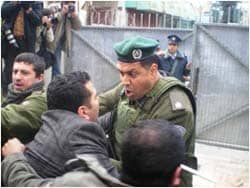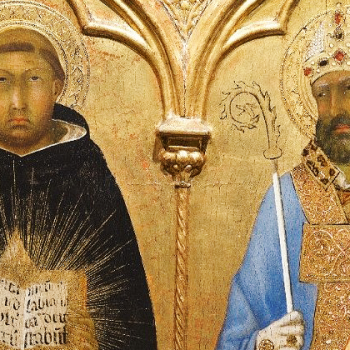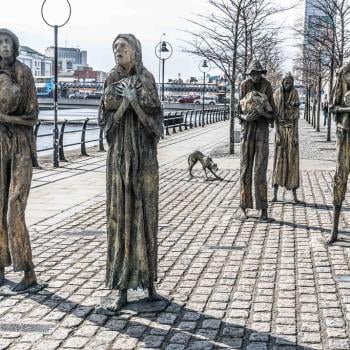Twelve years later, in retaliation for the killing of a yeshiva student, settlers began moving into properties in the central marketplace that had once been owned by Jews. Eventually, they established fortress-like enclaves in two old buildings, Beit Romano and Beit Hadassah, built a new apartment complex in the old Avraham Avinu neighborhood, and set up trailers on a hill known as Tel Rumeida.
The settlers had not come here to live quietly among their ancestors. Levinger was a spiritual founder of the Gush Emunim settler movement, and under his fiery leadership the settlers aggressively asserted Jewish domination, harassing Arabs who got in their way. "If they don't understand," one settler told me at the time of my first visit in August 1984, "they have just one possibility and this is to leave."
I had come then to report for the Washington Post on the new trailers filled with Jewish families that had appeared one night on Tel Rumeida. While the settlers did not have formal government approval, then-Defense Minister Moshe Arens of the right-of-center Likud party had told them he would look the other way while they set up the new enclave. Arens later praised the settler project in Hebron as "in many ways symbolic of everything that Zionism stands for and everything that Israel stands for."
This was the way the settlers routinely expanded their domain -- by grabbing land and establishing what they call "facts on the ground" with the tacit approval of at least part of the Israeli government of the day. Whether led by Likud or Labor, hawks or doves, the government seldom said no, reflecting, in part, the leverage that a small but determined interest group like the settlers can wield in Israel's fractured political system.
After my first trip, I rarely went back to Hebron. Frankly, the place frightened me -- the most rabid settlers and most extreme Palestinians trading insults, rocks, and occasional gunfire. In 1980, six settlers were killed when Arabs fired into their enclave from a rooftop. In turn, settlers shot dead three Palestinian students at Hebron University in 1982. Feeling trapped in the middle, Israeli commanders often complained about the violence and arrogance of the settlers. But when pressed, the army always sided with them.
 Palestinians tried to hold on. When I visited Hebron in 1993, the fruit and vegetable and chicken markets in the old souk near the center of town were still jammed with customers. Israeli soldiers patrolled these areas cradling automatic weapons. Every now and then a violent incident shattered the uneasy calm -- a Palestinian would stab a settler, settlers would rampage through the marketplace, beating Arabs and smashing shops, and soldiers would attempt to intervene. The two sides were practicing how to hate each other.
Palestinians tried to hold on. When I visited Hebron in 1993, the fruit and vegetable and chicken markets in the old souk near the center of town were still jammed with customers. Israeli soldiers patrolled these areas cradling automatic weapons. Every now and then a violent incident shattered the uneasy calm -- a Palestinian would stab a settler, settlers would rampage through the marketplace, beating Arabs and smashing shops, and soldiers would attempt to intervene. The two sides were practicing how to hate each other.
The turning point came in February 1994, when Goldstein stormed into the Ibrahimi Mosque above the Cave of the Patriarchs and opened fire. After the massacre, Prime Minister Yitzhak Rabin -- who himself was assassinated by a Jewish fanatic the following year -- briefly considered expelling the settlers but lacked the political will, according to Uri Dromi, who headed the Government Press Office at the time. Instead, fearing Palestinian retaliation, Rabin ordered the markets shut down, evicted hundreds of shopkeepers, and banned Palestinian vehicles. The army effectively established a sterile zone around the settlers. "The victim was punished twice," Taher Muhtaseb, vice president of the Hebron Chamber of Commerce, told me.
Under a 1997 agreement between Israel and the Palestinian Authority, Hebron was divided into two zones: a seven-square-mile area under Palestinian rule in which 135,000 Arabs live, and a 1.5-square-mile area under Israeli military control where 500 settlers and some 35,000 Palestinians reside. The line between the two zones ran right through the heart of the old city.
Three years later, Hebron became a major battleground during the second Palestinian uprising. Militant groups dispatched suicide bombers from Hebron to hit civilian targets inside Israel. When Prime Minister Ariel Sharon ordered the army to retake control of the West Bank's major cities and towns, the army laid siege for four days to the main Palestinian municipal and security headquarters in Hebron, then leveled it with explosives. Five months later, twelve Israeli soldiers and security guards were killed in an ambush while escorting worshippers from Sabbath prayers at the cave. Still, slowly but surely the Israeli army suppressed the uprising, and a modicum of order was restored.




